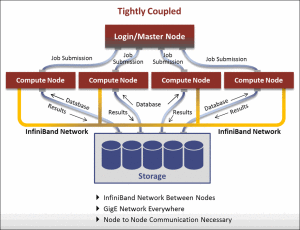Various industries have adopted or are in the planning and evaluation phase for using the cloud for HPC applications. Within the realm of technical computing, certain workloads are suited to a cloud-based HPC environment. Workloads could be considered either loosely coupled or tightly coupled. In each of the industries discussed below, multiple jobs submitted with different input parameters would be loosely coupled and not require a low-latency, high-speed interconnect, while a job that requires the use of multiple systems working in concert would be tightly coupled and need InfiniBand (IB).
Loosely Coupled System

Figure 1 shows a loosely coupled system where there is no need for node-to-node communication at high speed. – Click on image to enlarge the View
Tightly Coupled System With InfiniBand

Figure 2 diagrams a tightly coupled system where an IB network between the nodes is used for message passing between systems. – Click on image to enlarge the View
Computer-aided engineering (CAE) – As organizations design and develop products, the virtual testing for strength, reliability and operational capacity is well-suited for cloud computing. An organization’s CAE environment may include finite element analysis, computational fluid dynamics, large-scale deformation, electronic design automation and dynamic simulation. All of these workflows can be offloaded from internal systems to a cloud infrastructure, as these types of applications are self-contained.

This article is from the inisdeHPC Guide to Cloud Computing. Download it Now.
Life sciences – Genomics and computational chemistry are two examples of applications that can be offloaded to a cloud infrastructure. Each requires significant computing resources with a large number of cores for maximum application performance. In addition, many of these applications and algorithms lead to tremendous performance when GPU accelerators are available.
Research – General research and simulations of physical phenomena can be moved to the computing resources available from cloud providers. In many cases in this category, applications will be developed by the users and can be easily packaged to use the cloud resources. However, applications that would normally be run on a Top100 (www.top500.org) type system would not be applicable to a public cloud setup.
Energy exploration – Searching for the next oil or gas field requires significant computational power to move from the surveys to drilling locations. In addition, once the reservoir is discovered, simulating oil extraction is data and computationally demanding. A public cloud infrastructure would be ideal for this application. The only drawback would be the amount of data that must be uploaded for the application from the original acoustic sampling information.
Weather modeling and forecasting – Predicting the weather for the next hour, day, week or month has become extremely important for a wide range of organizations. Breaking up the water, land and atmosphere into massive amounts of 3D cells, scientists can model the chemistry and physics within that cell. The data (temperature, wind direction, etc.) then needs to be communicated to its neighboring cells and the simulation can continue. These applications require a very fast and low latency interconnect and are written using the MPI application programming interface.
This is fifth article in a series on Cloud Computing for HPC. If your prefer you can download the entire series in a PDF from the insideHPC White Paper Library, courtesy of Penguin Computing.




